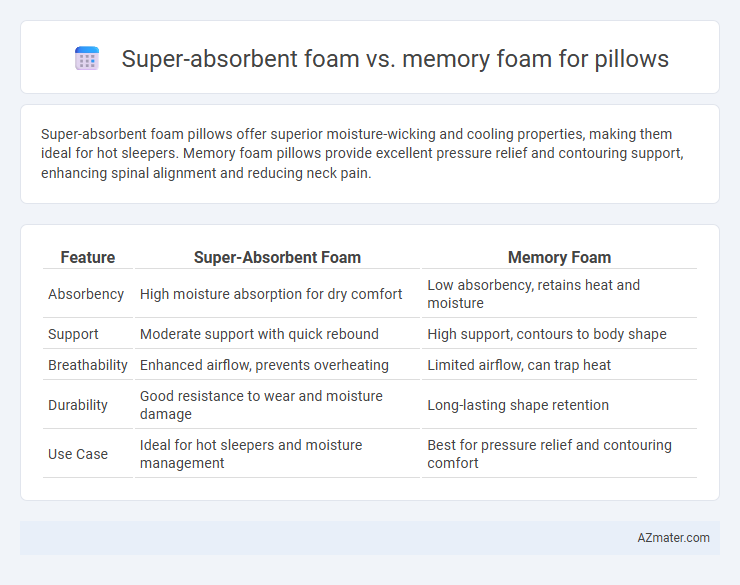Super-absorbent foam pillows offer superior moisture-wicking and cooling properties, making them ideal for hot sleepers. Memory foam pillows provide excellent pressure relief and contouring support, enhancing spinal alignment and reducing neck pain.
Table of Comparison
| Feature | Super-Absorbent Foam | Memory Foam |
|---|---|---|
| Absorbency | High moisture absorption for dry comfort | Low absorbency, retains heat and moisture |
| Support | Moderate support with quick rebound | High support, contours to body shape |
| Breathability | Enhanced airflow, prevents overheating | Limited airflow, can trap heat |
| Durability | Good resistance to wear and moisture damage | Long-lasting shape retention |
| Use Case | Ideal for hot sleepers and moisture management | Best for pressure relief and contouring comfort |
Introduction: Super-Absorbent Foam vs Memory Foam Pillows
Super-absorbent foam pillows excel in moisture management, offering superior breathability and quick-drying properties ideal for hot sleepers and those prone to night sweats. Memory foam pillows provide contouring support by responding to body heat and pressure, enhancing spinal alignment and reducing neck pain. Choosing between the two depends on individual sleep needs, with super-absorbent foam prioritizing cool, dry comfort and memory foam emphasizing ergonomic support.
What Is Super-Absorbent Foam?
Super-absorbent foam is a high-porosity material designed to efficiently absorb and retain moisture, making it ideal for pillows that require enhanced breathability and moisture management. Unlike memory foam, which contours to the shape of the head and neck for pressure relief, super-absorbent foam excels in wicking away sweat and maintaining a dry, comfortable sleep environment. This foam's unique cellular structure provides rapid moisture absorption without compromising support or durability in pillow applications.
Understanding Memory Foam Technology
Memory foam technology utilizes viscoelastic polymers that respond to heat and pressure, contouring to the sleeper's head and neck for personalized support and pressure relief. Super-absorbent foam, while excellent for moisture control, lacks the adaptive molding properties that characterize memory foam. Choosing between these foams depends on prioritizing contouring comfort or enhanced moisture absorption in pillow performance.
Absorption Capabilities: Sweat and Moisture Control
Super-absorbent foam offers superior sweat and moisture control by rapidly absorbing and locking in humidity, making it ideal for hot sleepers or those prone to night sweating. Memory foam, while providing excellent contouring and pressure relief, tends to retain heat and moisture due to its dense structure, which can lead to discomfort over time. Choosing super-absorbent foam pillows enhances breathability and maintains dryness, promoting a cooler and more hygienic sleep environment.
Comfort and Support: Head and Neck Alignment
Super-absorbent foam pillows excel at moisture control, maintaining a dry surface that enhances comfort while providing moderate support for head and neck alignment. Memory foam pillows conform closely to the natural contours of the head and neck, delivering targeted support that promotes spinal alignment and reduces pressure points for improved overall comfort. Both materials contribute to ergonomic sleep posture, but memory foam's adaptive properties offer superior contouring for optimal head and neck support.
Durability and Longevity Comparison
Super-absorbent foam pillows exhibit superior durability due to their resilient cellular structure that resists wear and maintains firmness over time, making them ideal for long-term use. Memory foam pillows, while providing excellent contouring and pressure relief, tend to soften and lose shape with prolonged use, leading to reduced lifespan compared to super-absorbent options. The dense composition of super-absorbent foam contributes to enhanced longevity, often outperforming memory foam in maintaining structural integrity and consistent support.
Breathability and Temperature Regulation
Super-absorbent foam pillows excel in breathability due to their open-cell structure, which allows for superior air circulation and moisture absorption, maintaining a cooler sleeping surface. Memory foam pillows, while offering excellent contouring support, tend to retain heat because of their dense composition, leading to reduced airflow and potential discomfort for hot sleepers. Temperature regulation in super-absorbent foam is enhanced by its ability to disperse moisture quickly, whereas memory foam often requires additional cooling technologies, such as gel infusions, to mitigate heat retention.
Allergy Friendliness and Hygiene
Super-absorbent foam pillows offer superior moisture-wicking properties that reduce dust mite proliferation, enhancing allergy friendliness and maintaining hygiene. Memory foam pillows are dense and hypoallergenic but may retain heat and moisture, potentially promoting bacterial growth if not properly ventilated. Choosing pillows with antimicrobial treatments or breathable covers further improves allergy protection and hygiene maintenance.
Price Differences and Value for Money
Super-absorbent foam pillows typically cost more than memory foam due to advanced moisture-wicking technology, offering enhanced breathability and hygiene benefits. Memory foam pillows, while generally more affordable, provide superior contouring and pressure relief, appealing to those prioritizing comfort over moisture control. Assessing value for money involves balancing the higher price of super-absorbent foam against its long-term freshness advantages, compared to memory foam's proven ergonomic support at a lower initial cost.
Which Pillow Type Is Best for You?
Super-absorbent foam pillows excel in moisture management, making them ideal for individuals who tend to sweat during sleep or live in humid climates, as they keep the pillow dry and comfortable. Memory foam pillows conform closely to the shape of your head and neck, offering superior support and pressure relief, which is beneficial for those with neck pain or requiring spinal alignment. Choosing between super-absorbent foam and memory foam depends on whether you prioritize moisture-wicking properties or contouring support for a restful night's sleep.

Infographic: Super-absorbent foam vs Memory foam for Pillow
 azmater.com
azmater.com